Crete for Seniors: Things to Do in Crete for Older People and Pensioners

Crete, the largest Greek island, offers many experiences for seniors and older travelers. Seniors can explore the island by visiting ancient sites like the Palace of Knossos and the Heraklion Archaeological Museum. They can also stroll through towns and villages, such as Chania and Rethymno. Crete features beaches for those interested in nature, such as Elafonissi and Balos, where seniors can swim in crystal-clear waters or simply relax on the shore. The island’s rugged interior is home to hiking trails, including the famous Samaria Gorge, which physically fit seniors can enjoy. Foodies will delight in Crete’s culinary offerings, with opportunities to dine in traditional tavernas, sample local wines and even take cooking classes.
Listed below are the best things for seniors to do in Crete.
- Palace of Knossos: The Palace of Knossos, located in Knossos, Greece, is a significant archaeological site dating back to the Bronze Age. It served as the hub of the Minoan civilization, making it Europe’s oldest city.
- Archaeological Museum of Heraklion: The Archaeological Museum of Heraklion features an extensive collection of Minoan artifacts showcasing Greece’s ancient culture. It is easily accessible on foot or by public transport and offers a compact layout suitable for older visitors.
- Koules Fortress: Koules Fortress, also known as Rocca al Mare, is a 16th-century Venetian fortress guarding Heraklion’s old port. It is free to enter and offers historical insights and views of the Cretan Sea. Easily accessible on foot, it’s suitable for seniors, with a flat and well-paved path.
- Local Tavernas in Heraklion and Chania: Exploring local tavernas in Heraklion and Chania explores seniors in traditional Greek cuisine and culture. With affordable prices and easily accessible locations, these tavernas cater to older visitors.
- Arkadi Monastery: Arkadi Monastery, a historic site in Crete, offers free admission and insight into the region’s religious heritage. Accessible by car or bus, it provides a setting for exploration.
- Cooking Class on Greek Food: Taking a cooking class on Greek food in Crete offers seniors a hands-on culinary experience. Suited for food and culture lovers, these classes accommodate all skill levels and physical abilities, ensuring an enjoyable and educational experience.
- Elafonissi Beach: Seniors can enjoy the natural beauty and calm waters of Elafonissi Beach, known for its pink sands and turquoise sea. Free access and easily accessible by car or bus, it offers a relaxing environment for swimming and sunbathing.
- Samaria Gorge: Samaria Gorge, a UNESCO Biosphere Reserve, offers a challenging hiking experience through natural landscapes. Accessible by car or bus, it’s suitable for physically fit seniors.
- Botanical Park and Gardens of Chania: The Botanical Park and Gardens of Chania provide seniors with a peaceful outdoor experience surrounded by diverse plant life.
- Cretan Winemaking Traditions: Exploring Cretan winemaking traditions allows seniors to learn about the island’s viticultural heritage. Tours and tastings are available at local wineries, making it a delightful activity for wine lovers.
- Spa Treatment in Nearby Hotels: Seniors can explore spa treatments at nearby hotels, offering relaxation and rejuvenation during their stay in Crete. With trained staff and accessible facilities, hotel spas cater to the needs of older guests and provide a retreat.
- Toplou Monastery: Toplou Monastery, a 15th-century Greek Orthodox monastery, invites seniors to explore its historic architecture and religious significance. With affordable admission and accessible grounds, it’s an enriching experience for those interested in history and culture.
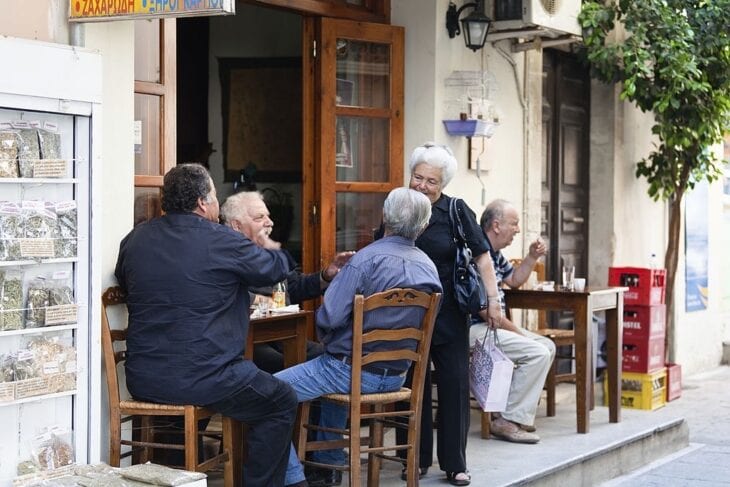
1. Visit the Palace of Knossos
The Palace of Knossos is a Bronze Age archaeological site in Knossos 714 09, Greece. It was the center of the Minoan civilization and is considered Europe’s oldest city. The palace complex covers an area of 20,000 square meters (215,278 square feet). Entrance fees for the Palace of Knossos are €15 ($16.35, £13.05) from April 1 to October 31 and €8 ($8.72, £6.96) from November 1 to March 31. Reduced ticket prices are available for seniors at €8 ($8.72, £6.96) during the high season and €4 ($4.36, £3.48) during the low season. The Palace of Knossos is located 5 kilometers (3.11 miles) southeast of Heraklion, the capital city of Crete. The site is easily accessible by bus or taxi from the city center. Seniors should know that the palace involves walking on uneven surfaces and stairs, which may be challenging for those with mobility issues. Guided tours allow seniors to explore slower and take breaks when needed. Knossos Palace is a popular attraction for history lovers, particularly those interested in ancient civilizations and archaeology. It offers a fascinating look into the Minoan culture and is suitable for seniors who enjoy learning about history and exploring ancient ruins.
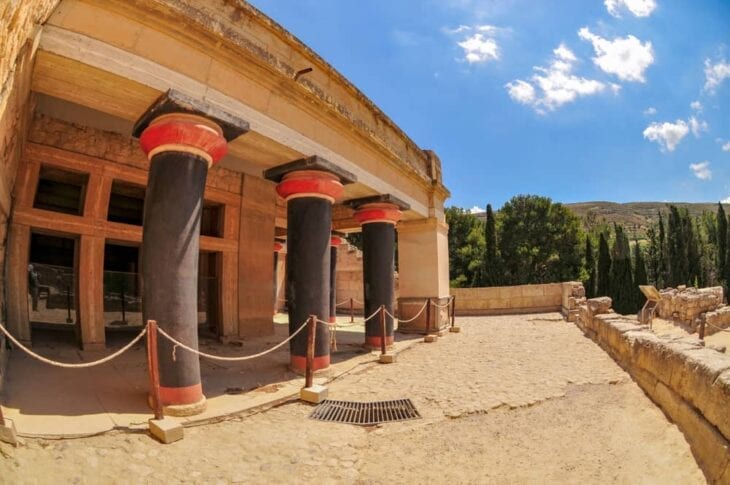
2. Explore the Archaeological Museum of Heraklion
The Archaeological Museum of Heraklion is located in Ξανθουδίδη και, Chatzidaki 1, Iraklio 712 02, Greece. It houses an extensive collection of artifacts from the Minoan civilization, making it one of the most important museums in Greece for understanding this ancient culture. Admission to the museum is €10 ($10.90, £8.70) for adults, with a reduced price of €5 ($5.45, £4.35) for seniors over 65. The museum offers free admission on certain days throughout the year, such as International Museum Day (May 18) and World Tourism Day (September 27). The Heraklion Archaeological Museum is in the heart of the city, 500 meters (0.31 miles) from the city center. It is easily accessible on foot or by public transportation, with several bus stops nearby. The museum is well-suited for seniors, as it offers a relatively compact and manageable layout, with elevators and benches available for those who need to rest. The museum is an ideal attraction for seniors interested in history, archaeology and ancient civilizations. Its extensive collection of Minoan artifacts, including pottery, frescoes and jewelry, provides a comprehensive understanding of this fascinating culture. The museum’s exhibits are well-labeled and informative, making it an enjoyable and educational experience for older visitors.
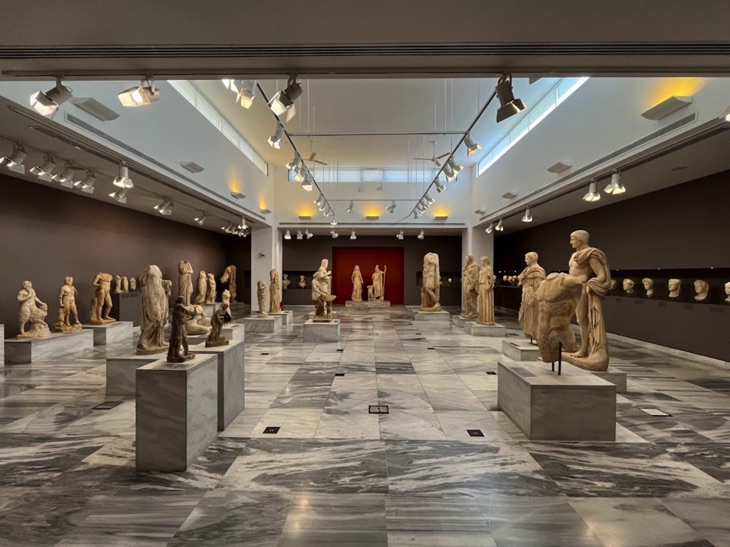
3. Visit Koules Fortress
Koules Fortress, also known as Rocca al Mare, is a 16th-century Venetian fortress located at the entrance of the old port of Heraklion, Crete, Greece. The fortress was built to protect the city from attacks by sea and served as a prison during the Ottoman occupation. The fortress is in Heraklion, 1 kilometer (0.62 miles) from the city center. It is easily accessible on foot, making it a convenient attraction for seniors. The walk along the old port to reach the fortress is flat and well-paved, suitable for those with limited mobility. Seniors who get quickly tired can take breaks or take a taxi ride to the fortress. Entrance to Koules Fortress is free, making it an affordable attraction for seniors on a budget. Koules Fortress is an ideal attraction for seniors interested in history, architecture and sea views. The fortress looks into Crete’s Venetian and Ottoman past, while its location provides views of the Cretan Sea and the surrounding coastline. Seniors can explore the fortress at their own pace, taking breaks as needed and enjoying the views from the walls. The site is suitable for seniors with limited mobility, as it does not involve extensive walking or climbing.
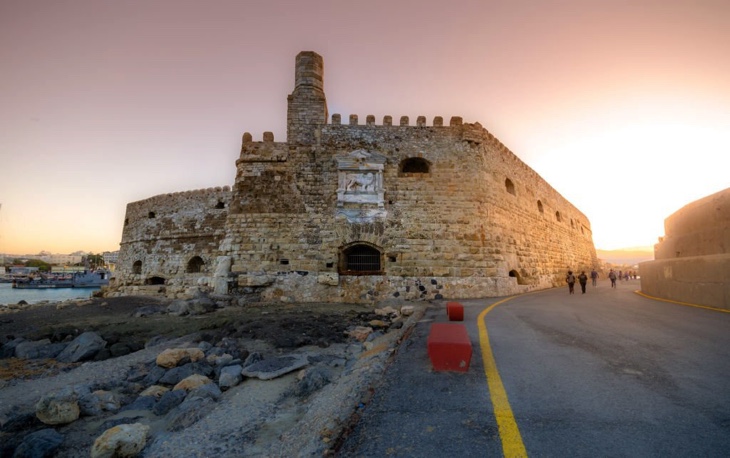
4. Dine in local tavernas of Heraklion and Chania
Dining in local tavernas is a must-do experience for seniors visiting Heraklion and Chania, two of the largest cities in Crete, Greece. Tavernas are traditional Greek restaurants that serve authentic, home-style cuisine in a casual and welcoming atmosphere. Heraklion and Chania have numerous tavernas scattered throughout their city centers and surrounding neighborhoods. These tavernas are easily accessible on foot or by short taxi rides, making them convenient for seniors to visit. Seniors who get quickly tired can choose tavernas close to their accommodation or take breaks during their walks to restaurants. Prices in local tavernas are generally affordable, with main dishes ranging from €8 ($8.72, £6.96) to €15 ($16.35, £13.05). Many tavernas also offer smaller portions or half-portions, ideal for seniors with smaller appetites. Dining in local tavernas is perfect for seniors who want to explore themselves in Greek culture and enjoy traditional Cretan cuisine. The relaxed atmosphere and friendly service make it a comfortable experience for older visitors. Seniors can take their time savoring their meals, engaging in conversation and soaking up the lively of these authentic establishments. The tavernas are suitable for seniors with limited mobility, as they typically offer comfortable seating and easy access.
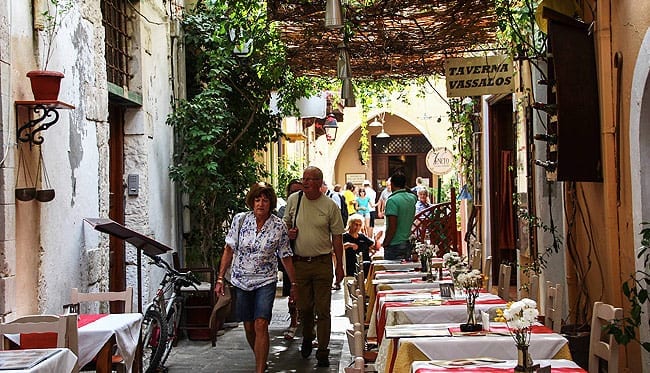
5. Explore Arkadi Monastery
Arkadi Monastery is a historic Eastern Orthodox monastery in the Rethymno regional unit of Crete, Greece. The monastery played a significant role in the Cretan resistance against the Ottoman occupation, particularly during the 1866 Cretan Revolt. The monastery is on a plateau 20 kilometers (12.4 miles) southeast of Rethymno and 81 kilometers (50.3 miles) southwest of Heraklion. Visitors can reach the monastery by car or bus, with parking available on-site. Seniors who get easily tired may find the walk from the parking area to the monastery entrance slightly uphill, but benches are available along the way for rest stops. Entrance to Arkadi Monastery is free, making it an affordable attraction for seniors on a budget. Arkadi Monastery is an ideal attraction for seniors interested in history, religion and architecture. The monastery’s well-preserved buildings, including the church and the museum, offer insight into the region’s religious and cultural heritage. Seniors can explore the monastery grounds independently, taking breaks as needed. The site is primarily accessible for seniors with limited mobility, although some areas may involve a few steps.
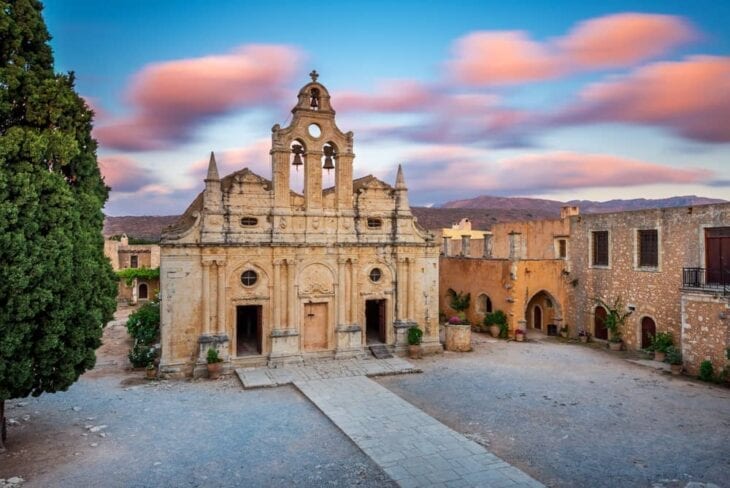
6. Take a cooking class on Greek Food
A cooking class on Greek food is an enjoyable and educational activity for seniors visiting Crete. Cooking classes offer a hands-on experience where participants learn to prepare traditional Greek dishes using local ingredients and techniques. Cooking classes are available throughout Crete, including popular cities such as Heraklion, Chania and Rethymno. Many classes are held in traditional Cretan homes or restaurants, providing an authentic setting for learning about Greek cuisine. The proximity of the classes to the nearest town or city varies, but most are easily accessible by taxi or public transportation. The cost of cooking classes on Greek food in Crete typically ranges from €50 ($54.50, £43.50) to €100 ($109.00, £87.00) per person. The price usually includes instruction, ingredients and a meal at the end of the class. Cooking classes suit seniors who enjoy food, culture and socializing. The hands-on nature of the classes allows seniors to participate actively in the cooking process, learning new skills and recipes. Most classes are designed to accommodate participants of all skill levels and physical abilities, with instructors providing guidance and support as needed. Seniors who get quickly tired can take breaks during the class or request a seat while cooking.

7. Swim in Elafonissi Beach
Elafonissi Beach is a renowned beach in the southwest of Crete, Greece. The beach is famous for its crystal-clear turquoise waters, soft white sand and pink hues from crushed seashells. Elafonissi Beach is 73 kilometers (45.4 miles) southwest of Chania and 211 kilometers (131.1 miles) southwest of Heraklion. Visitors can reach the beach by car, bus or organized tour. The beach is easily accessible from the parking area, with a short walk along a wooden boardwalk. Access to Elafonissi Beach is free, making it an affordable destination for seniors. Elafonissi Beach is ideal for seniors who enjoy natural beauty, relaxation and swimming in calm, shallow waters. The beach’s soft sand and clear, shallow waters suit seniors with limited mobility or who prefer a more relaxed swimming experience. The beach is well-organized, with sun loungers and umbrellas available for rent and nearby cafes and restaurants for refreshments.
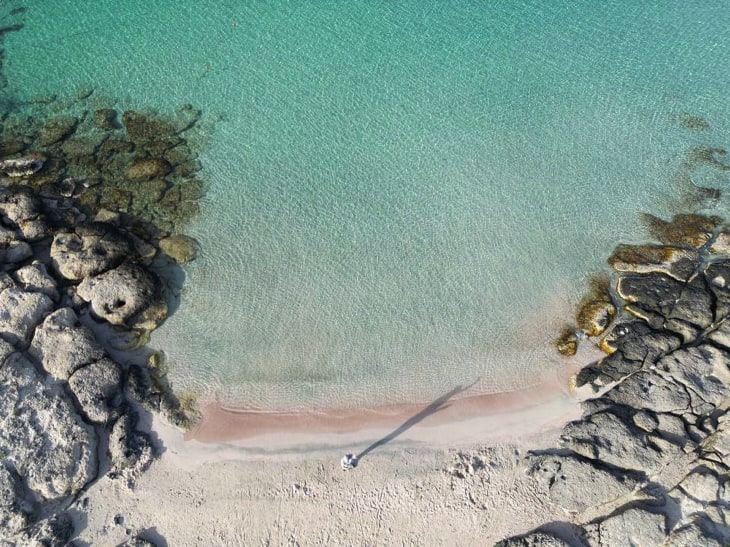
8. Hike Samaria Gorge
Samaria Gorge is a National Park and UNESCO Biosphere Reserve located in the White Mountains of Crete, Greece. The gorge is one of the longest in Europe, stretching 16 kilometers (9.94 miles) from the Omalos Plateau to the shores of the Libyan Sea. The gorge’s entrance is 88 kilometers (54.67 miles) south of Chania and 159 kilometers (98.80 miles) southwest of Heraklion. Visitors can reach the gorge by car or bus to the Omalos Plateau, where the hiking trail begins. The hike through the gorge is 16 kilometers (9.94 miles) long and ends at the coastal village of Agia Roumeli. The entrance fee to Samaria Gorge is €5 ($5.45, £4.35) per person, making it an affordable hiking experience for seniors. Hiking Samaria Gorge is suitable for physically fit seniors who enjoy outdoor activities. The hike is challenging, with a total descent of 1,250 meters (4,101 feet) and an average hiking time of 6 to 8 hours. Seniors should be prepared for a long day of walking on uneven terrain with steep and rocky sections. The trail in Samaria Gorge is well-maintained, with rest stops and water sources. Seniors who get easily tired may find the hike challenging and should assess their physical capabilities before attempting the trek.
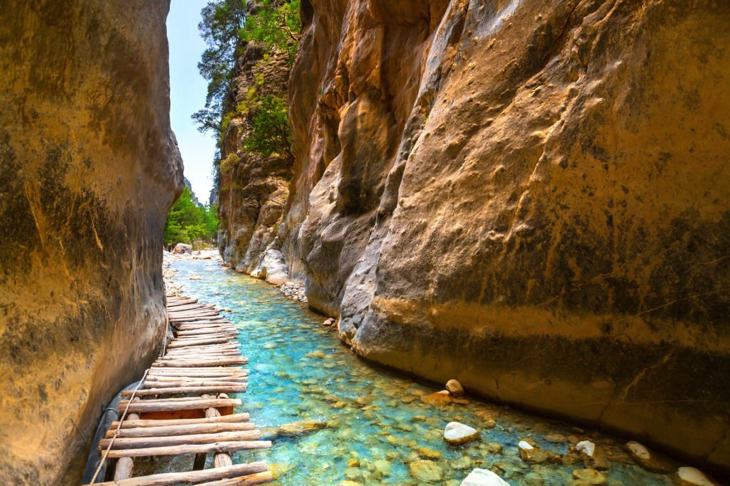
9. Visit the Botanical Park and Gardens of Chania
The Botanical Park and Gardens of Chania is a beautiful oasis located 600 meters (0.37 miles) southwest of Chania, Crete. The park covers an area of 200,000 square meters (49.42 acres) and features a diverse collection of plants worldwide and a restaurant serving traditional Cretan cuisine. The park is easily accessible by car or taxi, with ample on-site parking. Visitors can also reach the park by bus from Chania, with the bus stop located just a short walk from the entrance. Admission to the Botanical Park and Gardens of Chania is €7 ($7.63, £6.09) for adults and €5 ($5.45, £4.35) for seniors over 65 years old. The Botanical Park and Gardens of Chania is an ideal destination for seniors who enjoy nature, gardening and a relaxing outdoor experience. The park offers well-maintained walking paths that wind through the various gardens, allowing seniors to explore independently. Benches and rest areas are scattered throughout the park, providing ample opportunities for seniors to take breaks and enjoy the surroundings.
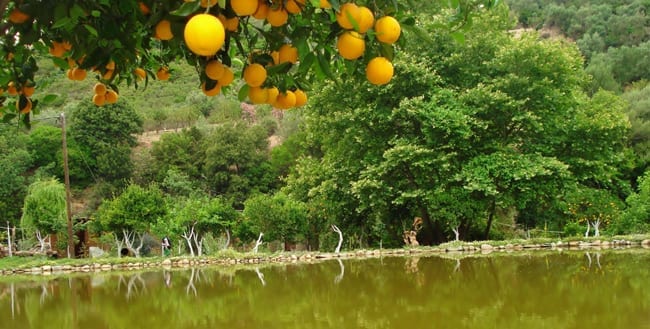
10. Learn about Cretan winemaking traditions
Crete has a long and rich history of winemaking, with the tradition dating back to the Minoan civilization. Learning about Cretan winemaking traditions is an enjoyable and educational experience for seniors visiting the island. Many wineries across Crete offer tours and tastings, allowing visitors to learn about the island’s unique grape varieties and winemaking techniques. Some popular wine regions include Heraklion, Chania and Rethymno, with wineries in the surrounding countryside. The distance from the nearest town or city varies depending on the winery, but most are easily accessible by car or organized tour. The cost of winery tours and tastings in Crete ranges from €10 ($10.90, £8.70) to €30 ($32.70, £26.10) per person, depending on the winery and the type of experience offered.
Learning about Cretan winemaking traditions is an excellent activity for seniors who appreciate wine, history and culture. Winery tours typically involve walking through the vineyards and cellars, with guides providing information about the winemaking process and the region’s viticultural heritage. Seniors who get quickly tired can take breaks during the tour or opt for a seated tasting experience. Most wineries are well-equipped to accommodate seniors, with accessible facilities and knowledgeable staff who can adapt the experience to individual needs.
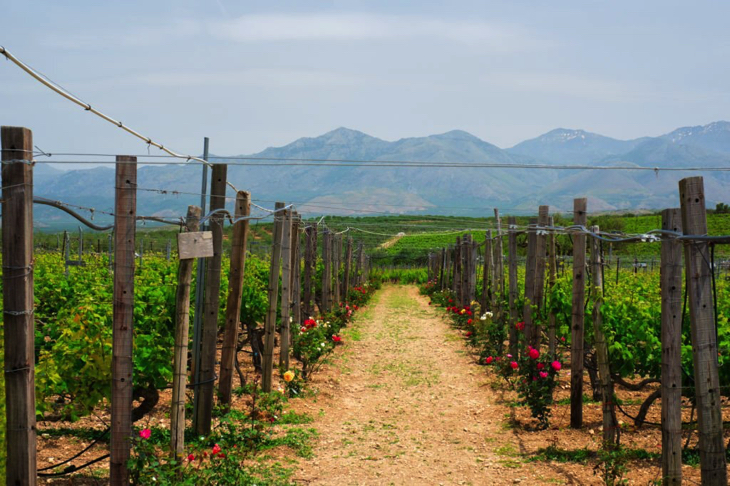
11. Get a spa treatment in a nearby hotel
Many hotels in Crete offer spa treatments, which can provide seniors with a relaxing and rejuvenating experience. Spa treatments can include massages, facials, body wraps and hydrotherapy, among other services. Spa facilities are typically located within the hotel premises, making them easily accessible for senior guests. The distance from the nearest town or city varies depending on the hotel’s location, but most hotels offering spa services are located in popular tourist areas, such as Heraklion, Chania, Rethymno and Agios Nikolaos. The cost of spa treatments in Cretan hotels varies depending on the type of treatment and the duration. Prices can range from €30 ($32.70, £26.10) for a 30-minute massage to €120 ($130.80, £104.40) or more for a complete spa package. A spa treatment is ideal for seniors who want to unwind, relax and care for their physical and mental well-being. Spa hotel facilities are designed to be accessible and accommodating to seniors, with trained staff who can tailor treatments to individual needs and preferences. Seniors with limited mobility can enjoy spa treatments that do not require excessive movement, such as facial treatments or seated massages. The relaxing atmosphere and comfortable surroundings of hotel spas make them an excellent choice for seniors looking to pamper themselves during their stay in Crete.
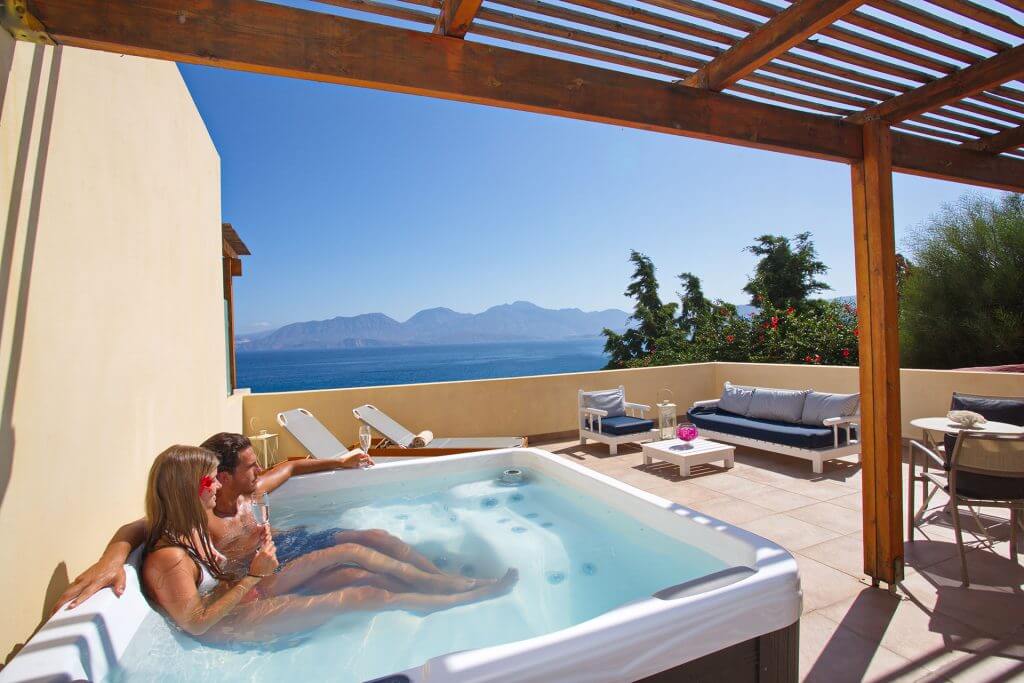
12. Visit Toplou Monastery
Toplou Monastery, also known as the Monastery of Panagia Akrotiriani, is a 15th-century Greek Orthodox monastery in the Lasithi regional unit of eastern Crete. The monastery is known for its fortified architecture, frescoes and history. The monastery is 9.3 kilometers (5.8 miles) north of the village of Palekastro and 81 kilometers (50.3 miles) east of Agios Nikolaos. Visitors can reach the monastery by car or taxi, with parking near the entrance. Entrance to Toplou Monastery costs €3 ($3.27, £2.61) per person. Visiting Toplou Monastery is an excellent activity for seniors interested in history, religion and architecture. The monastery’s well-preserved buildings and beautiful frescoes offer insight into the region’s cultural and spiritual heritage. Seniors can explore the monastery grounds at their own pace, taking breaks as needed in the peaceful surroundings. Toplou monastery is mainly accessible for seniors with limited mobility, although some areas may involve a few steps or uneven surfaces. Seniors who get tired can take their time and rest in the monastery’s courtyard or gardens, enjoying the atmosphere and views of the surrounding landscape.
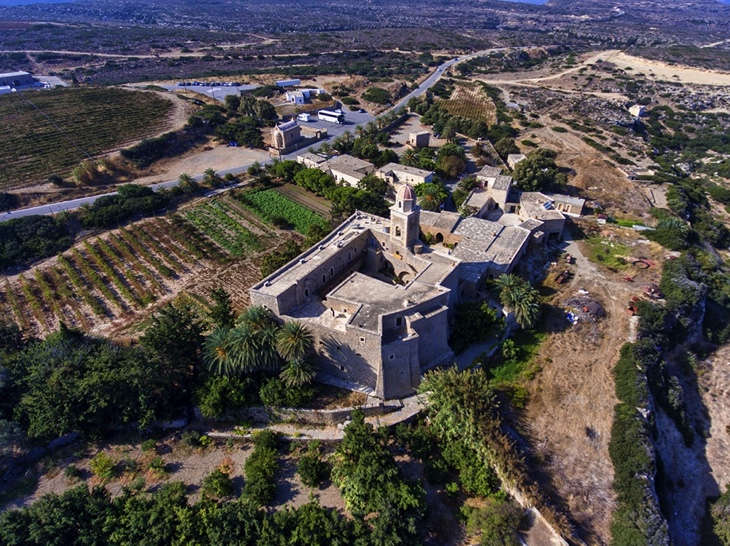
Why do Seniors choose Crete?
Crete is a popular destination for seniors due to several factors. The island offers a pleasant Mediterranean climate with mild temperatures and sunshine, making it comfortable for older travelers. Crete also features a history and culture, with numerous archaeological sites, museums and traditional villages to explore leisurely. The slow-paced lifestyle and friendly locals create a welcoming atmosphere for seniors seeking relaxation and a change of pace. Crete has a well-established tourism infrastructure with many accommodation options, including hotels, resorts and vacation rentals catering to older travelers’ needs. The island also has a sound healthcare system, with modern medical facilities and English-speaking doctors, providing peace of mind for seniors with health concerns. Crete’s cuisine, based on fresh, locally sourced ingredients and the Mediterranean diet, is not only delicious but also considered healthy, appealing to health-conscious seniors.
Are there any senior-friendly transportation options or services available in Crete?
Yes, several senior-friendly transportation options in Crete are available depending on individual preferences and needs. Find below the best transportation options for seniors in Crete.
- Car rentals. Car rentals are considered the best option for seniors who are eligible and confident drivers. Renting a car provides the flexibility to explore the island at one’s own pace, allowing for impromptu stops and detours to exciting locations.
- Taxis. Taxis are a comfortable alternative for those who prefer not to drive. Taxis in Crete are generally high-end vehicles, offering a pleasant and relaxing travel experience. Taxi drivers are often knowledgeable about the island and can provide valuable insights and recommendations to senior travelers.
- Buses. Buses are a cost-effective transportation option in Crete, seniors may not be a more comfortable choice. Bus rides can be crowded and bumpy, with limited space for luggage and frequent stops. Some bus routes may not directly serve certain tourist attractions or accommodations, requiring additional walking or transfers. Seniors with mobility issues or specific comfort requirements may find buses less suitable.

What precautions should seniors should be aware of when visiting Crete?
Listed below are the precautions seniors should be aware of.
- Sun protection: Seniors should take precautions against the strong Mediterranean sun by wearing wide-brimmed hats, sunglasses and high-SPF sunscreen. They should also consider wearing lightweight, long-sleeved clothing for added protection. Staying hydrated by drinking plenty of water throughout the day, especially during outdoor activities, is important. Seniors should seek shade during the hottest hours, typically between 11 am and 4 pm, to reduce the risk of heat exhaustion and sunburn.
- Mobility considerations: Seniors with mobility issues should research their accommodation and destination beforehand to ensure accessibility. Many older buildings in Crete may need elevators and some streets can be narrow, uneven or cobblestoned. Seniors should consider booking accommodations with ground-floor rooms or elevators and should inquire about wheelchair accessibility if necessary.
- Medication and health: Seniors should bring an adequate supply of their prescription medications, a copy of their prescriptions and a list of generic drug names. They should also consider getting a small first-aid kit with basic supplies such as bandages, antiseptic and pain relievers. It is important to have travel health insurance that covers medical emergencies and evacuation, just in case.
- Food and water safety: Food and water in Crete are generally safe, so seniors should take some precautions to avoid stomach upsets or foodborne illnesses. They should drink bottled water and avoid ice cubes made from tap water. Seniors should choose restaurants with good hygiene practices and opt for fully cooked, hot meals.
- Emergency contacts and communication: Seniors should carry a list of emergency contacts, including family members and their doctor, in case of any health issues or emergencies. They should also have a means of communication, such as a mobile phone with international roaming or a local SIM card, to stay connected with loved ones and to contact emergency services if needed.
- Scams and safety: Seniors should be aware of common scams and take precautions to protect their safety and belongings. They should be cautious of overly friendly strangers or individuals offering unsolicited services, as these may be attempts to distract or overcharge them. Seniors should keep their valuables, such as passports and credit cards, in a secure location and avoid carrying large amounts of cash,
Do the elderly have any discounts when booking travel plans in Crete?
No, it is not common for travel companies, hotels or attractions to offer specific discounts for elderly travelers in Crete. Unlike some countries where senior discounts are widely available, the Greek culture does not have a strong tradition of providing such discounts. This means that elderly visitors should not expect to find special rates or promotions based on their age when booking travel plans in Crete. There are opportunities to save money or find good deals. Travelers of all ages can look for seasonal promotions, early booking discounts or package deals that can help reduce the cost of their trip. It is also worth noting that some museums or archaeological sites in Crete may offer reduced admission fees for older visitors, but these discounts are not widespread and should be confirmed on a case-by-case basis.
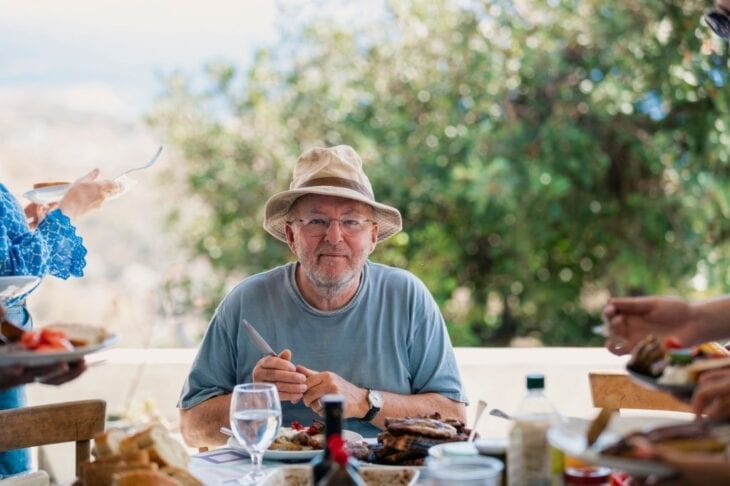
Are there any senior-friendly transportation options available in Crete?
Yes, there are several senior-friendly options for island visitors. One popular Crete transportation is the minivan taxi service, which provides comfortable and spacious vehicles that can easily accommodate groups of seniors traveling together. These minivans are well-maintained and equipped with air conditioning, ensuring a pleasant ride even during the warmer months. Another option is the stroller-friendly taxi service, which caters to seniors with mobility issues or those who require a wheelchair or stroller. These taxis are specially adapted with ramps or lifts to facilitate easy boarding and disembarking. The drivers of these vehicles are trained to assist passengers with special needs, offering a safe and reliable transportation experience.
Can seniors rent a car in Crete?
Yes, car rental companies generally allow seniors to rent vehicles, but age restrictions apply. Most Crete car rental providers require drivers to be at. There typical upper age limit for renting a car in Crete is from 70 to 75 years old. Seniors can rent a vehicle if they meet the minimum age requirement of each company and have a valid driver’s license. Crete car rental companies may charge an additional fee for drivers over a certain age, typically from 70 or 75. Seniors should also be aware that some car rental companies may require a medical certificate or a letter from a doctor confirming their fitness to drive.
What is the maximum age limit to rent a car in Crete?
The maximum age limit to rent a car in Crete is typically between 70 and 75 years old. This means that individuals 70 years or older may face additional restrictions or be unable to rent a car, depending on the specific car rental company’s policies. Some car rental providers in Crete may require seniors over 70 to provide additional documentation, such as a medical certificate or a letter from a doctor confirming their fitness to drive. In some cases, car rental companies may also charge a senior driver fee for individuals over 70 years old to cover increased insurance costs.
What car rental model do seniors mostly choose?
There are several car rentals seniors mostly choose. Smaller cars are often preferred due to their ease of parking and maneuverability on the island’s narrow roads. Fiat Panda is a popular choice among senior renters. This compact city car offers a surprisingly spacious interior and a comfortable ride, making it suitable for exploring Crete’s towns and villages. The Toyota Aygo is another favorite among older drivers. This small hatchback is known for its fuel efficiency and easy handling. It can benefit seniors who want to save on gas costs and confidently navigate the island. Nissan Micra is a reliable option for senior renters. This subcompact car provides a smooth driving experience and features a user-friendly interior layout, making it easy for seniors to adjust to the vehicle’s controls. Renault Clio is a well-rounded choice for senior travelers. This supermini car offers a balance of comfort, practicality and style, with ample space for luggage and passengers. A Volkswagen Polo is a solid choice for seniors who value German engineering and build quality. This subcompact car offers a refined driving experience and a well-crafted interior, ensuring a pleasant journey throughout Crete.
What are the visa and residency requirements for seniors looking to retire in Crete?
Listed below are the visa and residency requirements for seniors.
- Visa requirements: Seniors from EU countries can retire in Crete without a visa, as they have the right to live, work and retire in any EU member state. However, non-EU citizens must apply for a long-term visa, such as a national visa (Type D), which allows them to stay in Greece for more than 90 days. To obtain this visa, seniors must provide proof of sufficient funds, health insurance and a clean criminal record.
- Residency permits: After arriving in Crete, non-EU seniors must apply for a residency permit within 60 days. They must submit documents such as a valid passport, visa, proof of accommodation, health insurance and sufficient financial means to support themselves. The residency permit is initially granted for two years and can be renewed afterward. EU citizens must also register with local authorities and obtain a residence certificate if staying in Crete for over three months.
- Proof of financial means: Seniors retiring in Crete must demonstrate sufficient funds to support themselves without relying on the Greek welfare system. This can be in the form of a pension, savings or other regular income. The minimum required amount may vary depending on individual circumstances and the current economic situation in Greece.
- Health insurance: Retirees in Crete must have comprehensive health insurance coverage. For EU citizens, this can be achieved through the European Health Insurance Card (EHIC) or by registering with the Greek public healthcare system (EOPYY). Non-EU seniors may need to obtain private health insurance that covers them in Greece or register with EOPYY if they become permanent residents.
- Tax implications: Seniors retiring in Crete should be aware of the tax implications of their move. Their tax residency status may require them to pay taxes on their worldwide income in Greece. It is essential to consult with a tax professional to understand the specific tax obligations and any double taxation agreements between Greece and their home country.
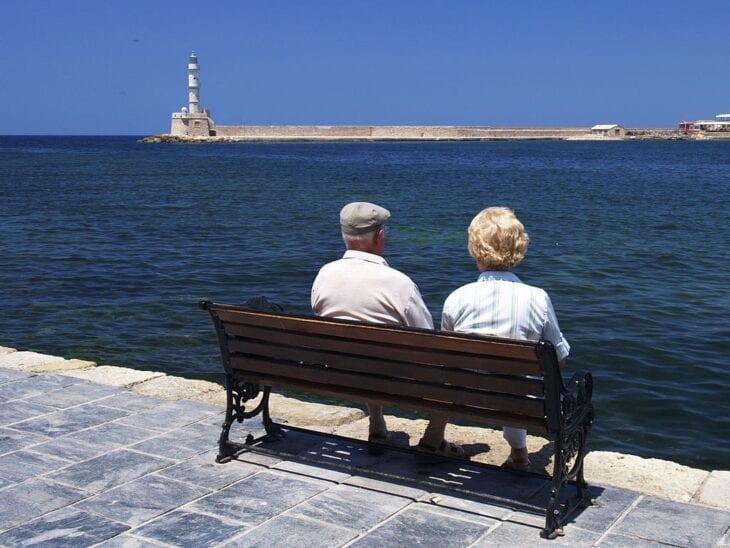
Last updated on February 11th, 2025















